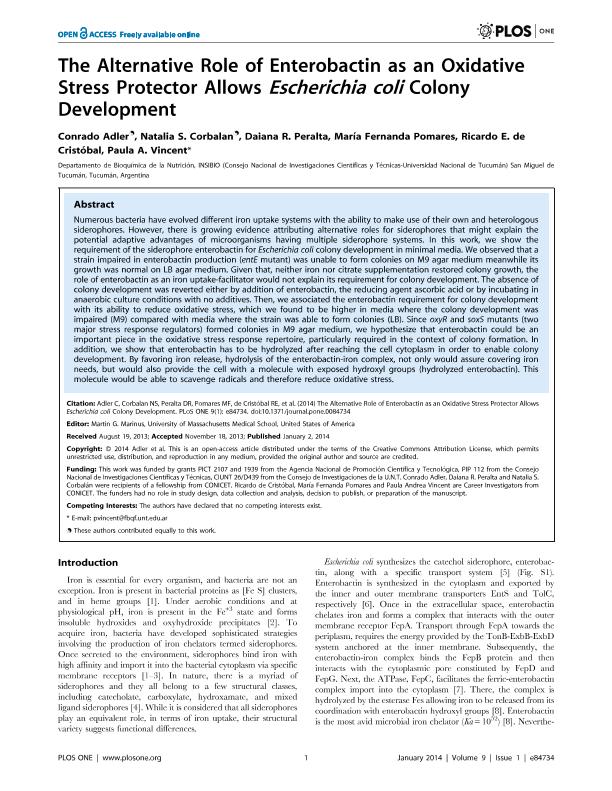Mostrar el registro sencillo del ítem
dc.contributor.author
Adler, Conrado

dc.contributor.author
Corbalan, Natalia Soledad

dc.contributor.author
Peralta, Daiana Romina

dc.contributor.author
Pomares, Maria Fernanda

dc.contributor.author
de Cristobal, Ricardo Ezequiel

dc.contributor.author
Vincent, Paula Andrea

dc.date.available
2017-12-11T21:13:24Z
dc.date.issued
2014-01
dc.identifier.citation
Adler, Conrado; Corbalan, Natalia Soledad; Peralta, Daiana Romina; Pomares, Maria Fernanda; de Cristobal, Ricardo Ezequiel; et al.; The Alternative Role of Enterobactin as an Oxidative Stress Protector Allows Escherichia coli Colony Development; Public Library of Science; Plos One; 9; 1; 1-2014; 1-10; e84734
dc.identifier.issn
1932-6203
dc.identifier.uri
http://hdl.handle.net/11336/30202
dc.description.abstract
Numerous bacteria have evolved different iron uptake systems with the ability to make use of their own and heterologous siderophores. However, there is growing evidence attributing alternative roles for siderophores that might explain the potential adaptive advantages of microorganisms having multiple siderophore systems. In this work, we show the requirement of the siderophore enterobactin for Escherichia coli colony development in minimal media. We observed that a strain impaired in enterobactin production (entE mutant) was unable to form colonies on M9 agar medium meanwhile its growth was normal on LB agar medium. Given that, neither iron nor citrate supplementation restored colony growth, the role of enterobactin as an iron uptake-facilitator would not explain its requirement for colony development. The absence of colony development was reverted either by addition of enterobactin, the reducing agent ascorbic acid or by incubating in anaerobic culture conditions with no additives. Then, we associated the enterobactin requirement for colony development with its ability to reduce oxidative stress, which we found to be higher in media where the colony development was impaired (M9) compared with media where the strain was able to form colonies (LB). Since oxyR and soxS mutants (two major stress response regulators) formed colonies in M9 agar medium, we hypothesize that enterobactin could be an important piece in the oxidative stress response repertoire, particularly required in the context of colony formation. In addition, we show that enterobactin has to be hydrolyzed after reaching the cell cytoplasm in order to enable colony development. By favoring iron release, hydrolysis of the enterobactin-iron complex, not only would assure covering iron needs, but would also provide the cell with a molecule with exposed hydroxyl groups (hydrolyzed enterobactin). This molecule would be able to scavenge radicals and therefore reduce oxidative stress.
dc.format
application/pdf
dc.language.iso
eng
dc.publisher
Public Library of Science

dc.rights
info:eu-repo/semantics/openAccess
dc.rights.uri
https://creativecommons.org/licenses/by-nc-sa/2.5/ar/
dc.subject
Enerobactin
dc.subject
Oxidative Stress
dc.subject
Colony Development
dc.subject.classification
Otras Ciencias Biológicas

dc.subject.classification
Ciencias Biológicas

dc.subject.classification
CIENCIAS NATURALES Y EXACTAS

dc.title
The Alternative Role of Enterobactin as an Oxidative Stress Protector Allows Escherichia coli Colony Development
dc.type
info:eu-repo/semantics/article
dc.type
info:ar-repo/semantics/artículo
dc.type
info:eu-repo/semantics/publishedVersion
dc.date.updated
2017-12-11T19:25:58Z
dc.journal.volume
9
dc.journal.number
1
dc.journal.pagination
1-10; e84734
dc.journal.pais
Estados Unidos

dc.journal.ciudad
San Francisco
dc.description.fil
Fil: Adler, Conrado. Consejo Nacional de Investigaciones Científicas y Técnicas. Centro Científico Tecnológico Conicet - Tucumán. Instituto Superior de Investigaciones Biológicas. Universidad Nacional de Tucumán. Instituto Superior de Investigaciones Biológicas; Argentina
dc.description.fil
Fil: Corbalan, Natalia Soledad. Consejo Nacional de Investigaciones Científicas y Técnicas. Centro Científico Tecnológico Conicet - Tucumán. Instituto Superior de Investigaciones Biológicas. Universidad Nacional de Tucumán. Instituto Superior de Investigaciones Biológicas; Argentina
dc.description.fil
Fil: Peralta, Daiana Romina. Consejo Nacional de Investigaciones Científicas y Técnicas. Centro Científico Tecnológico Conicet - Tucumán. Instituto Superior de Investigaciones Biológicas. Universidad Nacional de Tucumán. Instituto Superior de Investigaciones Biológicas; Argentina
dc.description.fil
Fil: Pomares, Maria Fernanda. Consejo Nacional de Investigaciones Científicas y Técnicas. Centro Científico Tecnológico Conicet - Tucumán. Instituto Superior de Investigaciones Biológicas. Universidad Nacional de Tucumán. Instituto Superior de Investigaciones Biológicas; Argentina
dc.description.fil
Fil: de Cristobal, Ricardo Ezequiel. Consejo Nacional de Investigaciones Científicas y Técnicas. Centro Científico Tecnológico Conicet - Tucumán. Instituto Superior de Investigaciones Biológicas. Universidad Nacional de Tucumán. Instituto Superior de Investigaciones Biológicas; Argentina
dc.description.fil
Fil: Vincent, Paula Andrea. Consejo Nacional de Investigaciones Científicas y Técnicas. Centro Científico Tecnológico Conicet - Tucumán. Instituto Superior de Investigaciones Biológicas. Universidad Nacional de Tucumán. Instituto Superior de Investigaciones Biológicas; Argentina
dc.journal.title
Plos One

dc.relation.alternativeid
info:eu-repo/semantics/altIdentifier/doi/http://dx.doi.org/10.1371/journal.pone.0084734
dc.relation.alternativeid
info:eu-repo/semantics/altIdentifier/url/http://journals.plos.org/plosone/article?id=10.1371/journal.pone.0084734
Archivos asociados
